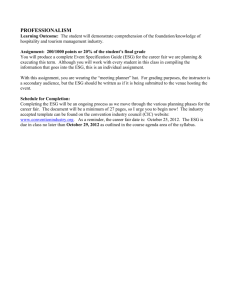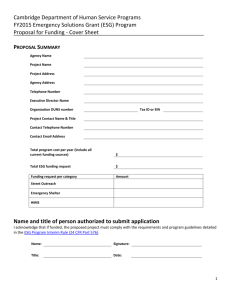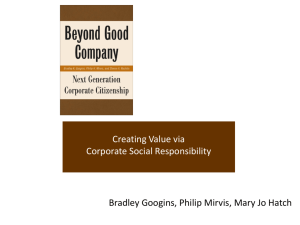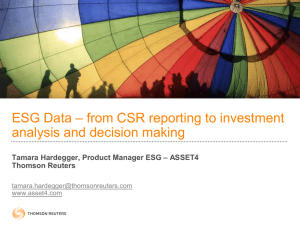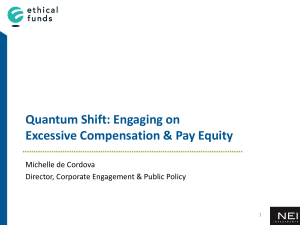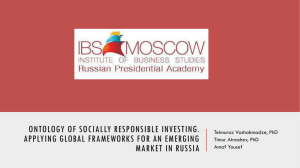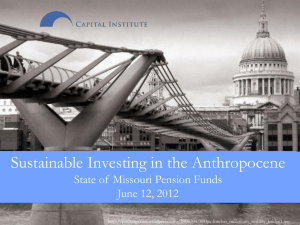The Big Idea
advertisement
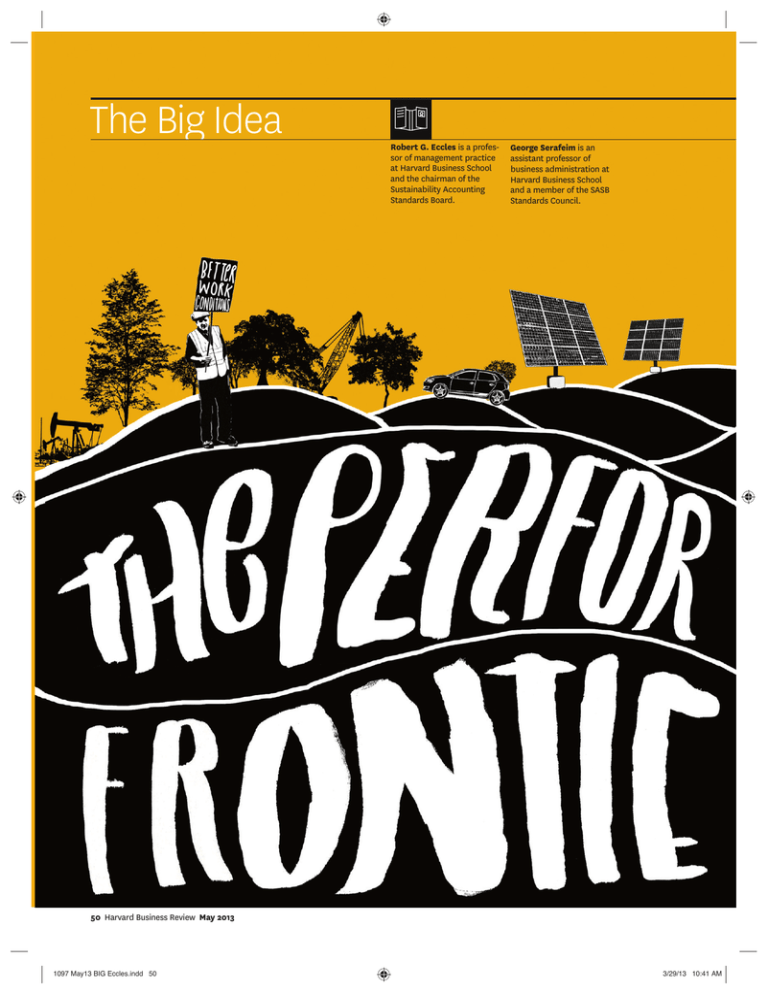
The Big Idea Robert G. Eccles is a professor of management practice at Harvard Business School and the chairman of the Sustainability Accounting Standards Board. George Serafeim is an assistant professor of business administration at Harvard Business School and a member of the SASB Standards Council. 50 Harvard Business Review May 2013 1097 May13 BIG Eccles.indd 50 3/29/13 10:41 AM HBR.ORG Innovating for a sustainable strategy by Robert G. Eccles and George Serafeim May 2013 Harvard Business Review 51 1097 May13 BIG Eccles.indd 51 3/29/13 10:41 AM THE BIG IDEA THE PERFORMANCE FRONTIER: INNOVATING FOR A SUSTAINABLE STRATEGY B y now most companies have sustainability programs. They’re cutting carbon emissions, reducing waste, and otherwise enhancing operational efficiency. But a mishmash of sustainability tactics does not add up to a sustainable strategy. To endure, a strategy must address the interests of all stakeholders: investors, employees, customers, governments, NGOs, and society at large. ILLUSTRATION: PETER STRAIN LOW FINANCIAL PERFORMANCE HIGH those whose programs—relevant or not—depress To do that, it has to increase shareholder value while financial results. at the same time improving the firm’s performance In this article we examine the trade-offs and proon environmental, social, and governance (ESG) vide a framework for creating sustainable strategies dimensions. that—by definition—simultaneously boost both Companies understand this, but too often they launch programs with the hope that they’ll be finan- financial and ESG performance. It requires compacially rewarded for “doing good,” even when the is- nies to do two things: focus strategically on the most sues they address aren’t relevant to their strategy “material” ESG issues—the ones that have the greatest impact on the firm’s ability to create shareholder and operations. Largely missing from these efforts value; and produce major innovations in products, is a clear understanding of the very real trade-offs that exist between financial and ESG performance. processes, and business models that prioritize those concerns. Improving one typically comes at a cost to the other. While using expensive solar energy is good for the environment, it’s often bad for the bottom Innovation and Performance line; paying workers above-market wages benefits The penalties for ignoring ESG issues can be harsh. the community but eats into profits. The capital Foxconn, Apple’s manufacturer in China, was remarkets know this only too well. As a result they minded of this in 2010, when revelations about don’t reward firms for ESG programs that fail to the deplorable working conditions in its factories enhance financial performance, and they punish unleashed a firestorm of bad press and ultimately halved its market cap. BP is still mopping up after the catastrophe on its Deepwater Horizon oil rig in THE PERFORMANCE FRONTIER the Gulf of Mexico—as much a managerial as an In the absence of substantial innovation, the financial performance engineering disaster. And the banking giant UBS of firms declines as their environmental, social, and governance (ESG) performance improves. To simultaneously improve both kinds learned—after an estimated $200 billion outflow of of performance, they need to invent new products, processes, and private client assets, fines of $780 million, and presbusiness models. sure from national governments to disclose clients’ names—that in the age of transparency, hiding beMAJOR hind Swiss secrecy laws is not a good strategy. INNOVATION In each case the company prioritized financial MODERATE INNOVATION over ESG performance, putting controls in place to prevent similar debacles only after the fact. Misguided decisions like these are made because the MINOR INNOVATION costs of negative externalities (external consequences of the company’s activities), such as pollution or abusive labor practices, are often borne by NO society, to the benefit of shareholders. Conversely, INNOVATION activities that help society, such as voluntarily reHIGH LOW ESG PERFORMANCE ducing emissions or investing in youth education initiatives, often create costs for the firm. SOURCE AUTHORS’ ECONOMETRIC ANALYSIS OF MORE THAN 3,000 ORGANIZATIONS 52 Harvard Business Review May 2013 1097 May13 BIG Eccles.indd 52 3/29/13 10:41 AM HBR.ORG Idea in Brief Investments in sustainability programs often require tradeoffs in companies’ financial performance, but this doesn’t have to be. By strategically focusing on the environmental, social, and governance (ESG) issues that are the most relevant—or “material”—to shareholder value, firms can simultaneously boost both financial and ESG performance. Firms must do four things to achieve this: • Identify which ESG issues are most critical in their particular business. Materiality Maps that the Sustainability Accounting Standards Board is creating for 88 industries can aid this process. • Quantify the financial impact that improvements on those issues would have. The exhibit on the previous page presents a conceptual model of this relationship. We developed this model through interviews, surveys, and several years of field research involving hundreds of companies across numerous sectors. Financial performance, as gauged by revenues, profit margins, stock price, and other metrics, is plotted on the Y axis; ESG performance, represented by lower carbon emissions and waste, fair labor practices, effective risk management, and other metrics, is captured on the X axis. The slope of a line (what’s shown represents a composite picture of more than 3,000 companies from 2002 to 2011) reveals the relationship between financial and ESG performance. The steeper the line’s downward slope, the greater the negative impact a firm’s ESG improvements have on financial performance; the steeper the upward slope, the greater the positive impact such improvements have. We call this line “the performance frontier.” Because of limitations on the measurement of ESG performance and the presence of myriad confounding variables such as leadership style and company culture, it is not yet possible to plot a precise graph for any single company. But our econometric analyses of 3,000-plus organizations confirm that if companies innovate, they can simultaneously improve ESG and financial performance and move the trajectory of the frontier line upward. Pushing the Frontier While minor innovations, such as efficiency improvements, can nudge a downward-sloping performance frontier up a bit, only major innovations in products, processes, or business models can shift the slope from descending to ascending. Such innovations are high risk, involving large-scale investments and long payback periods (often of five years or more). Typically, they concern a bundle of related • Undertake major innovation in products, processes, and business models to achieve the improvements. • Communicate with stakeholders about those innovations. Integrated reporting, which combines financial and ESG performance information in one document, is an effective way to do this. To facilitate the process, companies must break down barriers to change—namely, incentive systems and investor pressure that emphasize shortterm performance; a shortage of required expertise; and capital-budgeting limitations that fail to account for projects’ environmental and social value. ESG issues and tackle significant, unsolved challenges in a sector. Four broad initiatives are required to develop the kind of innovation programs that create a sustainable strategy. 1 IDENTIFY MATERIAL ESG ISSUES The list of ESG concerns that could have a large impact on financial performance is long and broad. It ranges from emissions, water and energy use, and waste management to labor practices, community development, employee safety, and executive compensation. Whether an issue significantly affects a company’s ability to create long-term shareholder value depends on both the sector the firm operates in (carbon emissions are more material for a coalfired utility than for a bank) and its particular strategy (human rights are more material for a company using low-cost labor in developing countries than for a firm using skilled workers in developed countries). The Sustainability Accounting Standards Board (SASB), where one of us (Bob) is chairman and the other (George) is a member of the Standards Council, is currently devising a framework to help companies determine their material ESG issues. The nonprofit is developing standards for use by public corporations in disclosing performance on dozens of ESG measures. Central to the project is the creation of Materiality Maps for 88 industries in 10 sectors. Each map prioritizes 43 ESG issues, ranking their materiality for a given industry on a scale from 0.5 to 5, with 5 being most material. The higher the score for an issue, the greater its probable impact on a firm’s financial performance. At press time, SASB had completed maps for two sectors and 13 industries; new sector maps are expected to become available approximately every three months. Materiality is assessed through a rigorous process that examines “evidence of interest” by searchMay 2013 Harvard Business Review 53 1097 May13 BIG Eccles.indd 53 3/29/13 10:41 AM THE BIG IDEA THE PERFORMANCE FRONTIER: INNOVATING FOR A SUSTAINABLE STRATEGY ing thousands of source documents, from 10-Ks to media reports, for ESG keywords; and “evidence of economic impact” by evaluating whether management (or mismanagement) of the issue will affect valuation parameters such as revenue growth and return on capital. (See the sidebar “How to Determine ‘Materiality.’”) The “Which Issues Matter Most?” exhibit contains a map for the health care sector and ranks ESG dimensions for six industries. The most material ESG issues are shaded in a darker color. You can see that in the biotechnology industry, for instance, product quality and safety are paramount, whereas regulatory issues, access to services, and customer satisfaction are among the most important issues for managed care providers. Conversely, fuel management is hardly material at all in the biotech industry (although it is quite material in health care distribution), while supply chain standards are less material for health care distribution (although they are quite material in biotech). If a Materiality Map isn’t available for an industry, a company can join the SASB Industry Working Group for its sector to see the analysis under way and engage with shareholders and other stakeholders to develop a general sense of the relevance of various issues. A host of factors complicate evaluations of the relationship between ESG and financial performance. Not the least of them are limitations on the ability to precisely measure ESG performance—a challenge that SASB and others are working to address. Nevertheless, companies can make an informed estimate of the slope of the performance-frontier curve for any pair of ESG and financial variables by determining whether each incremental improvement in ESG performance causes a corresponding positive or negative change in financial results—or has no impact. 3 2 QUANTIFY THE RELATIONSHIP BETWEEN FINANCIAL AND ESG PERFORMANCE Once you understand your firm’s material ESG issues, assess the impact that improvements in each would have on financial performance. Such performance has many dimensions, of course. Depending on the company’s strategy and the issue being considered, the most important dimension could be cost reduction, revenue growth, or gross margin defense. In its “Plan A” sustainability program, the British retailer Marks & Spencer evaluated 180 ESG initiatives ranging from becoming carbon neutral to improving employee health, looking at how they’d affect sales, costs, the brand, employee motivation, and the resilience of the business. With some the impact was easy to measure; with others it wasn’t. In some cases the trade-offs between financial and ESG performance were clear. Because many initiatives required investments, Marks & Spencer conducted return-on-investment analyses to determine which projects to devote more resources to. INNOVATE PRODUCTS, PROCESSES, AND BUSINESS MODELS The analyses you’ve done will provide the foundation for your innovation strategy. Once you know which ESG issues to focus on, you should determine how the firm compares with its peers on them. Trade associations and the trade press can be useful resources for this. If your firm’s performance in an area—say, energy use or labor practices—falls short of industry benchmarks, getting it up above par is a first priority. At the very least it will mitigate your risks, since stakeholders tend to focus on industry laggards in campaigns aimed at increasing corporate ESG performance. Many improvements, such as reducing manufacturing waste, involve minor or moderate innovations that can enhance efficiency and, therefore, financial performance. Those sorts of innovations are increasingly necessary (but not sufficient) to ensure competitiveness. Addressing the most significant trade-offs between financial and ESG performance—challenges that are often unsolved in a sector—requires major, organization-wide innovation: entirely new products, processes, and business models that improve performance in “bundles” of material issues. Developing a single product or process innovation to address a specific issue may be part of the solution but in and of itself won’t shift the performance frontier for the company as a whole. Consider the cases of three very different companies that have instituted the kind of broad initiatives we’re talking about: Natura. The Brazilian cosmetics and fragrances company has implemented a major process innovation that supports its pioneering management culture and business model. For fiscal year 2002, Natura issued its first integrated annual report, which captured financial as well as environmental and so- 54 Harvard Business Review May 2013 1097 May13 BIG Eccles.indd 54 3/29/13 10:41 AM HBR.ORG How to Determine “Materiality” The Sustainability Accounting Standards Board (SASB) has identified five broad categories of environmental, social, and governance (ESG) issues that can affect a firm’s financial performance and therefore be highly material to investors. The materiality of any issue varies from one industry to the next, however. To gauge it within an industry, SASB evaluates evidence of interest by different types of stakeholders and evidence of economic impact. Companies can use a similar approach to find out which ESG issues are most material to their investors if SASB assessments for their industry are not yet available. cial performance. Natura was among the first companies in the world to make this shift, long before the practice had gained currency through the work of organizations like the International Integrated Reporting Council (the IIRC, where Bob is a council member). The company saw integrated reporting as the best way to signal its management’s focus on environmental and social stewardship and to ensure leadership’s commitment to those goals. In addition, the company has tied managers’ performance ratings and bonuses to environmental and social goals as well as financial results, so that decision making will be guided by all three types of measures. The company also pays close attention to stakeholders, formally seeking input from investors, customers, and employees on decisions that affect their interests. Indeed, Natura’s business model is predicated on a particular form of engagement: Its sales force of 1.4 million “consultants” share in the firm’s profits and serve as emissaries for the brand and conduits for customer and community feedback. Natura’s performance showcases the impact of its management culture, business model, and innovativeness in both products and processes. (In 2011, Forbes ranked Natura among the top 10 most innovative companies.) In Brazil, Natura—which launched 435 new products from 2009 to 2011—has a leading market share of 23.2% (greater than Unilever’s or Avon’s), a 62% household penetration rate, and nearly 100% brand recognition. From 2002 to 2011 the firm’s revenues grew by 463% and its net income by 3,722%, and the company had an average gross margin of 68%, compared with the industry average of 40%. In 2010, the company’s return on assets (24.7%) and return on equity (62.1%) also far surpassed industry averages. Financial analysis shows that the company’s high profitability was driven by exceptional operating performance and not by financial leverage. Since 2002, Natura has significantly reduced its greenhouse gas emissions and water consumption, developed more environ- EVIDENCE OF INTEREST is determined by searching tens of thousands of source documents using keywords. The results reveal the intensity with which issues arise in each industry. The documents examined include Form 10-Ks, legal news, CSR reports, shareholder resolutions, media reports, and innovation journals. EVIDENCE OF ECONOMIC IMPACT is determined by evaluating both anecdotal reports and quantitative studies to gauge whether management (or mismanagement) of the issue will affect traditional corporate valuation parameters: revenue growth, return on capital, risk management, and management quality. A FORWARD-LOOKING ADJUSTMENT acknowledges an emerging issue that is not yet reflected in these evidence-based tests. In a small number of cases, SASB may make an adjustment to raise the importance of an issue if the management (or mismanagement) of it might create positive or negative effects that other stakeholders, industries, or generations will have to deal with, or if there is the potential for systemic disruption. In any case, the effects must be reasonably likely to occur and of significant magnitude to be deemed material. mentally friendly packaging, and provided training and education opportunities to about 560,000 consultants. Dow Chemical Company. Dow has suffered ferocious public criticism of its environmental record, including outcries over its manufacture of the defoliant Agent Orange and the dioxin contamination near its Midland, Michigan, facilities. To understand and respond to stakeholder concerns, in 1992 the company recruited a group of leading scientists and policy experts to form an advisory body charged with challenging the firm on its environmental goals and processes. Among other things, the experts recommended that the company shift its focus from how to get rid of waste to eliminating waste altogether. Dow ultimately embraced aggressive wastereduction targets and to that end launched two decades’ worth of massive innovation in new products, such as solar-cell shingles, and processes, including new health and safety procedures that drastically reMay 2013 Harvard Business Review 55 1097 May13 BIG Eccles.indd 55 3/29/13 10:41 AM THE BIG IDEA THE PERFORMANCE FRONTIER: INNOVATING FOR A SUSTAINABLE STRATEGY HBR.ORG WHICH ISSUES MATTER MOST? 56 Harvard Business Review May 2013 1097 May13 BIG Eccles.indd 56 HEALTH CARE DISTRIBUTION MANAGED CARE 3.75 3.75 1.25 0.75 0.75 1.00 Environmental accidents and remediation 0.75 1.25 1.50 1.00 1.00 0.75 Water use and management 1.00 1.25 1.25 1.00 1.00 1.00 Energy management 2.25 2.50 2.25 3.75 1.00 1.75 Fuel management and transportation 0.50 0.75 0.75 0.50 2.25 0.50 1.00 HEALTH CARE DELIVERY PHARMACEUTICALS ENVIRONMENT SOCIAL CAPITAL HUMAN CAPITAL BUSINESS MODEL & INNOVATION MEDICAL EQUIPMENT & SUPPLIES BIOTECH Climate change risk ESG ISSUES IN HEALTH CARE LEADERSHIP & GOVERNANCE duced the number of leaks, breaks, and spills. As Dow improved its sustainability performance, its strategy evolved to include helping its customers address their own environmental challenges—a $350 billion market opportunity. In every year since 2009, EBITDA that is directly attributable to new-product innovation has exceeded $400 million at Dow. It hit $1 billion in 2012 and is projected to reach $2 billion by 2015. The company has also grown the net present value of its R&D pipeline from $5 billion in 1997 to $33 billion in 2011. Innovative new products, many of which offer improved sustainability performance, account for 90% of that pipeline’s value. CLP Group. Electric utilities are in a bind when it comes to optimizing both carbon emissions and financial performance. On one hand, pressure to limit emissions is growing—though inexpensive and dirty coal remains the chief technology for electricity generation. On the other, consumers expect low prices and investors want decent and predictable returns. Complicating matters, the regulatory environment governing carbon emissions is murky at best and varies from country to country. How can a company meet these conflicting expectations in an uncertain environment? Hong Kong– based CLP Group has found the answer through a business model innovation that gives it unusual agility in balancing renewable and nonrenewable sources of energy generation across regions as regulatory conditions and technologies change. First, it has developed analytic capabilities that allow it to optimize when and how it makes use of low-carbon energy sources, including solar, wind, and hydroelectric power. Second, it has become skilled at responding strategically to the regulatory regimes in its diverse markets. And finally, CLP has learned to monitor new technology developments and figure out how they can make alternative energy sources more viable. The stock market has recognized the potential of this new and more flexible business model. From 2005 to 2012 CLP’s shares outperformed the S&P index of electric utilities by 20 percentage points (48% versus 28%). CLP’s price/earnings ratio rose from 17 in 2005 to 24 in 2012—a 41% increase. In contrast, the P/E ratio for the index of electric utilities declined by 10%, from 19 to 17, within the same time period. Because the P/E ratio reflects the expected growth in the firm’s earnings and the cost of capital investors need as compensation for their risk, these numbers suggest that investors require a lower cost of capital SASB’s Materiality Maps, like this one for the health care sector, rate how relevant 43 environmental, social, and governance issues in five categories are to shareholders, on a scale from 0.5 to 5.0. The higher the number, the greater the probable impact on a firm’s financial performance. GHG emissions and air pollution 1.00 1.00 1.75 1.00 1.00 Waste management and effluents 3.00 3.00 2.50 2.25 1.25 0.75 Biodiversity impacts 1.00 0.75 1.00 1.25 1.00 1.00 Communications and engagement 1.00 1.00 0.75 1.00 0.50 1.25 Community development 0.50 0.75 0.75 1.75 1.25 0.50 Impact from facilities 0.50 1.00 1.00 4.00 1.25 1.00 Customer satisfaction 0.75 0.75 1.00 2.25 1.00 3.00 Customer health and safety 5.00 5.00 3.00 3.00 1.50 2.50 Disclosure and labeling 3.00 3.00 2.50 0.75 2.75 0.75 Marketing and ethical advertising 2.50 2.50 2.50 1.75 2.00 1.75 Access to services 4.25 4.50 2.50 3.00 3.00 3.00 Customer privacy 0.75 0.75 1.00 2.25 1.75 2.75 New markets 3.50 3.75 1.00 0.75 0.75 0.75 Diversity and equal opportunity 1.25 1.25 1.00 1.25 1.25 1.25 Training and development 3.00 2.75 2.00 2.50 1.50 2.00 Recruitment and retention 2.25 2.50 1.50 3.00 1.75 1.50 Compensation and benefits 1.75 1.75 1.50 1.25 1.25 1.00 Labor relations and union practices 1.75 1.75 1.75 1.25 1.75 1.25 Employee health, safety, and wellness 2.00 2.00 2.00 2.00 2.50 1.50 Child and forced labor 0.50 0.75 0.75 0.50 0.50 0.50 Long-term viability of core business 0.75 0.75 0.75 0.50 0.75 3.50 Accounting for externalities 0.50 0.50 0.50 0.50 0.50 3.00 Research, development, and innovation 5.00 5.00 4.75 1.00 0.75 0.75 Product societal value 2.75 3.00 3.00 3.00 0.50 2.50 Product life-cycle use impact 3.75 3.75 4.50 0.75 2.25 0.75 Packaging 1.00 1.00 1.00 0.50 0.75 0.50 2.50 Product pricing 2.50 2.50 2.50 2.50 2.50 Product quality and safety 5.00 5.00 3.00 5.00 3.00 2.25 Regulatory and legal challenges 3.00 3.00 3.00 3.00 3.00 3.00 Policies, standards, and codes of conduct 2.50 2.50 2.25 1.00 1.75 1.00 Shareholder engagement 0.75 0.75 0.75 0.75 0.75 3.00 Business ethics and competitive behavior 2.50 2.50 2.50 2.50 3.00 2.00 Board structure and independence 1.25 1.50 1.25 1.50 1.50 1.25 Executive compensation 1.00 1.00 1.00 0.75 1.00 0.75 Lobbying and political contributions 0.50 0.75 0.75 1.25 1.00 0.75 Raw material demand 0.75 0.75 0.75 0.50 0.75 0.50 Supply chain standards and selection 2.50 2.25 2.25 0.75 0.75 1.00 Supply chain engagement and transparency 0.75 1.00 0.75 1.00 0.50 0.50 ■ LOWER MATERIALITY ■ HIGHER MATERIALITY 3/29/13 10:41 AM THE BIG IDEA THE PERFORMANCE FRONTIER: INNOVATING FOR A SUSTAINABLE STRATEGY from CLP, since it is doing a better job of walking the tightrope between carbon emissions and economic performance. 4 COMMUNICATE THE COMPANY’S INNOVATIONS TO STAKEHOLDERS A company cannot assume that shareholders and other stakeholders will understand how its innovations have improved ESG and financial performance—and how the two interrelate—if it fails to communicate effectively. This is more than a matter of public relations; major innovations often require substantial investments whose benefits will not be seen for years to come. If a company expects shareholders to commit for the long term in order to receive those benefits, it needs to provide them with information that justifies their investments. Combining ESG and financial performance information in a single document, as Natura did, is an effective way to do this. While such integrated reporting remains the exception, it’s gaining momentum largely as a voluntary practice around the world—though it is now required of all companies listed on the Johannesburg Stock Exchange. To help promote it, the IIRC published a draft framework for integrated reports in the spring of 2013; it expects to release the final “version 1.0” in December. As a communications tool, integrated reporting involves more than posting a PDF on a company website. The most effective reporting is as much about listening as talking, and it serves as a key platform for stakeholder engagement. It’s a way to establish a conversation that considers a company’s performance in a holistic way, identifies the tough trade-offs, and builds a case for innovation and the benefits it can generate. This engagement is also central to eliciting feedback on how well the company is meeting expectations, the quality of its communications, and what it can do to improve them. Natura, for example, developed a virtual social network called Natura Conecta that invited the public to participate in discussions about corporate responsibility, sustainability, and people’s expectations of the company. In the first year more than 8,000 people registered and contributed to the company’s integrated reporting process. Participants in the network were invited to create a WikiReport for inclusion in the final integrated annual report. Finally, integrated reporting enhances discipline. It forces management and employees to think about HBR.ORG both the financial and the ESG implications of their decisions and helps spur innovation as they seek to improve both kinds of performance. Organizational Barriers to Change Though the imperative for developing a sustainable strategy is clear, the process often isn’t. In interviews with more than 200 executives and in-depth research on 30 companies engaged in the process, we’ve identified four barriers to change that must be overcome: Short-term incentives. Many employees, including senior managers, are rewarded for shortterm performance. Because addressing most sustainability issues requires a long-term outlook, firms’ incentive structures often undermine their ability to improve on ESG measures. Moreover, employees are frequently given incentives to boost the performance of their division or unit, but not corporatewide performance. This also works against ESG improvement as it discourages the cross-division collaboration that’s essential to innovation. As a firm that produces major commodities such as aluminum, copper, iron, coal, oil, and gas, BHP Billiton understands the business risks environmental mismanagement poses, and so has structured corporatewide executive compensation to protect its license to operate. In 2011 the company adopted a balanced scorecard approach for its ESG metrics, which include fatalities, environmental incidents, HSE (health, safety, and environment) risk management, human rights impact assessment, and environmental and occupational health. Fifteen percent of executives’ short-term incentives are now based on delivering on goals in those areas. (Though short-term, the incentives are designed to improve long-term ESG performance.) According to the company, linking remuneration to ESG performance has had a significant impact. For example, the amount of greenhouse gas the firm emitted per unit of energy consumed fell by 16% from 2006 to 2012, and in 2012 Billiton recorded its lowest injury rate in more than a decade. Shortage of expertise. New strategies that address environmental and social challenges often require new skill sets. When CLP realized it had to diversify its energy sources away from fossil fuels to include more hydroelectric, wind, and solar power, it had to recruit dozens of engineers with capabilities in those technologies. The new talent helped CLP increase the percentage of electricity from renewable sources that it delivers to customers from less than 1% in 2004 to 18% in 2011. 58 Harvard Business Review May 2013 1097 May13 BIG Eccles.indd 58 3/29/13 10:41 AM THE BIG IDEA THE PERFORMANCE FRONTIER: INNOVATING FOR A SUSTAINABLE STRATEGY HBR.ORG What Is a License to Operate? In discussions about corporate sustainability, the concept of a firm’s “license to operate” frequently arises, as does the potential for that license to be diminished or even lost. The State is the ultimate source of a corporation’s charter, which is where the license to operate begins. More broadly, the license is granted by society and represents a continuum of permission tto do business. Customers have to be willing to buy tthe firm’s products, suppliers to provide the materials tthe company needs to make tthem, and people to go to work there. Changing social expectations, such as those about firms’ responsibility for the environment and for their communities, can threaten the company’s license. These expectations are typically represented by nongovernmental organizations, which may put pressure on a company in a variety of ways (boycotts, social media campaigns, and lawsuits, for example). If the Capital-budgeting limitations. The long-term investments that most sustainlo ability improvements require make them ab unattractive to corporations that apply high un discount discoun rates in calculating projects’ net present values. Companies need to consider an expanded definition of value that takes into account the endefiniti vironmental and social worth of a project and what vironm for a company’s brand, ability to attract that means me employees, and license to operate. employ At Natura, senior vice president of finance RoN berto Pe Pedote and his team are working to develop a valuation valuatio model that more explicitly incorporates ESG ffactors. In one instance the company assessed a policy that would encourage managers to hire a significant number of people with handicaps at a new distribution center. While the financial costs of this policy were relatively easy to determine, the value to society, the value from increased employee morale and long-term productivity, and the positive impact on Natura’s reputation and brand were harder to quantify. Ultimately, Natura determined that the policy was a good investment. According to João Paulo Ferreira, vice president for operations and logistics, equipment at the center is undergoing adjustments to accommodate employees with physical and cognitive disabilities. The first group of employees hired under the new policy have been trained and are now working at the facility. Organizations that develop the tools to accurately incorporate nonfinancial metrics into their valuation methods and capital-budgeting processes will better understand the relationship between ESG and financial performance. Without such tools, firms will find it difficult to shift the slope of the performance frontier. Investor pressure. A company developing a sustainable strategy needs to attract farsighted in- company refuses to change its behavior, and NGO activity induces customers, suppliers, and employees to stop engaging with the company or the State takes action (such as levying fines), the firm’s ability to compete erodes. The license, though not literally revoked, is diminished—a situation no firm wants to find itself in. vestors that support this goal. Unilever, under CEO Paul Polman, achieved this by ceasing quarterly earnings guidance in 2009. The move sent a strong signal that the company wanted investors who were interested in the firm’s long-range prospects and would not put its strategy at risk by demanding maximum short-term profitability. Our research shows that through focused communications and integrated reporting, a company can actually increase its proportion of long-term investors. By analyzing the language that executives use during conference calls with sell-side analysts, for example, George has been able to document that companies with more long-term-oriented communications tend to attract more investors who are in it for the long haul. TODAY CORPORATIONS are larger than ever: Just 1,000 businesses now account for half of the total market value of the world’s 60,000 public companies. As they grow, firms will be under increasing pressure to devise sustainable strategies, creating economic value in ways that are consistent with the interests of customers, employees, and society at large. The organizational and management tools for accomplishing this, such as Materiality Mapping and integrated reporting, are still evolving and will be refined through experimentation and experience. This vast concentration of economic power gives companies the ability and the responsibility to assume roles that were previously the province of nations. By building sustainable strategies, the world’s most influential and innovative firms—perhaps more effectively than nations themselves—can pave the way to a sustainable society, one that meets the needs of the current generation without sacrificing those of generations to come. HBR Reprint R1305B 60 Harvard Business Review May 2013 1097 May13 BIG Eccles.indd 60 3/29/13 10:41 AM
